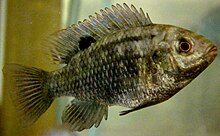Tilapia (genus)
| Tilapia | |
|---|---|

| |
| Banded tilapia, Tilapia sparrmanii | |
| Scientific classification | |
| Domain: | Eukaryota |
| Kingdom: | Animalia |
| Phylum: | Chordata |
| Class: | Actinopterygii |
| Order: | Cichliformes |
| Family: | Cichlidae |
| Tribe: | Tilapiini |
| Genus: | Tilapia A. Smith, 1840 |
| Type species | |
| Tilapia sparrmanii A. Smith, 1840
| |
| Species | |
|
4, see text | |
| Synonyms | |
|
Chromis Günther, 1862 (non Cuvier, 1814: preoccupied) | |
Tilapia is a genus of cichlid fishes endemic to freshwater habitats in Southern Africa. In the past this was a very large genus including all species with the common name tilapia, but today the vast majority are placed in other genera.[1]
Species and taxonomy
In the past, Oreochromis and Sarotherodon were retained in the genus Tilapia, but these are treated as separate genera by all recent authorities.[2] Even with this more restricted Tilapia, there were indications that the taxonomic treatment was problematic, and in 2013 a review of the group resulted in the removal of most "Tilapia" species to the genera Coelotilapia, Coptodon, Heterotilapia and Pelmatolapia.[1] With these as separate genera, only four species remain in Tilapia:[1]
- Tilapia baloni Trewavas & D. J. Stewart, 1975
- Tilapia guinasana Trewavas, 1936 (Otjikoto tilapia)
- Tilapia ruweti (Poll & Thys van den Audenaerde, 1965) (Okavango tilapia)
- Tilapia sparrmanii A. Smith, 1840 (Banded tilapia)
Temporarily retained here, but belonging elsewhere:[1]
- "Tilapia" brevimanus Boulenger, 1911 – closer to "Steatocranus" irvinei (itself not related to the remaining Steatocranus) and Gobiocichla.
- "Tilapia" busumana (Günther, 1903) – closer to "Steatocranus" irvinei (itself not related to the remaining Steatocranus) and Gobiocichla.
- "Tilapia" pra Dunz & Schliewen, 2010 – closer to "Steatocranus" irvinei (itself not related to the remaining Steatocranus) and Gobiocichla.
References
- ^ a b c d Dunz, A.R., and Schliewen, U.K. (2013). Molecular phylogeny and revised classification of the haplotilapiine cichlid fishes formerly referred to as “Tilapia”. Molecular Phylogenetics and Evolution, online 29 March 2013. doi:10.1016/j.ympev.2013.03.015
- ^ Nagl, S.; Tichy, H.; Mayer, W.E.; Samonte, I.E.; McAndrew, B.J., and Klein, J. (2001). Classification and Phylogenetic Relationships of African Tilapiine Fishes Inferred from Mitochondrial DNA Sequences. Molecular Phylogenetics and Evolution 20(3): 361–374. doi:10.1006/mpev.2001.0979
- Froese, Rainer; Pauly, Daniel (eds.). "Species in genus Tilapia". FishBase. April 2013 version.
